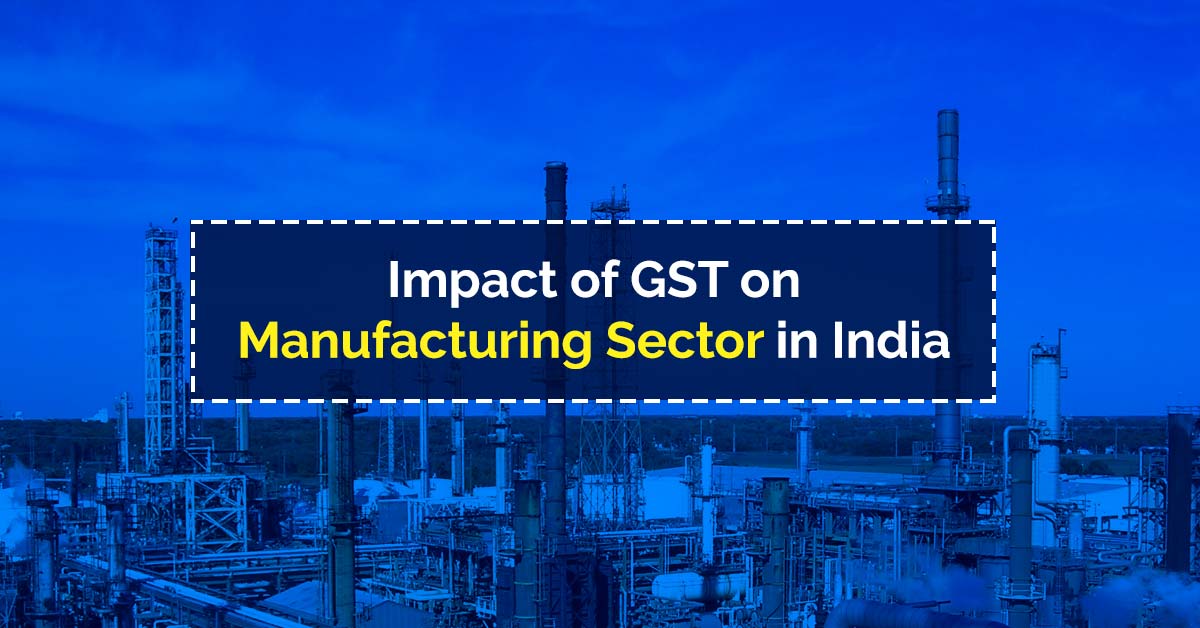Goods and Service Tax or GST was introduced in July last year. The unified tax system was aimed to restructure the indirect taxation system in India. GST was touted as a compulsory medicine for India’s lethargic tax system. In the long run, GST aims to establish the following key points:
- Foster business transparency.
- Facilitate ease of doing business.
- Increase tax compliance.
- Check and curb tax frauds.
In this blog, we look at the impact of GST on Manufacturing Sector. It has been more than six months since the new tax regime was implemented. As per industry experts and data from the Central Statistical Organization (CSO), the initial jolts of GST have withered away and there are good omens ahead for the Indian Economy. However, Manufacturing Sector it seems will still take some time to pick up the pace. 16 out of the 23 industrial groups in the manufacturing industry registered positive growth for the month of January 2018.
Lets now delve deep into the impact of GST on the Manufacturing Sector.
The Make in India Initiative
India’s global competitor, China, thrives on a GDP dominated by its humongous manufacturing sector. But in India, the reality is the stark opposite. Manufacturing Industry in India accounts for only 16% of the total GDP. Nevertheless, we cannot deny the fact that the sector upholds huge untapped potential that can drive high-GDP growth.
The Prime Minister, Mr. Narendra Modi’s “Make in India” comes as a huge boost and brings new agility to the rusted sector. By 2020, India, as per PwC estimates will be the fifth largest manufacturing country. GST is aimed to accelerate Indian Economies sprint for world dominance. However, it will also be for time to decide whether “Make In India” campaign was a passing gimmick or a true game-changer in the landscape of Indian Manufacturing industry.
Impact of GST on Indian Manufacturing Sector
GST unifies the earlier varying tax rates across entire length and breadth of the country. The GST eliminates this yesteryears complex tax regime by providing unified tax solution powered by the online GSTN Network. Overall, GST is expected to have a positive impact and boost manufacturing. The reasons for this are:
1. Simplified Transaction based Valuation :
The VAT tax regime levied excise duty that changed with state borders. Also, the parameters for calculating excise duty varied from state to state. These were:
- Based on transaction value.
- Based on quantity.
- Based on MRP Valuation.
Hence this created confusion and complex procedures for tax payments as well as calculation. GST only considers transaction-based valuation. This makes way for easier tax calculation as well as fosters easy and simple compliance procedures.
2. No additional State Entry tax:
GST subsumes the entry tax for inter-state transfers. This will benefit consumers by reducing the cost of goods and services. Earlier, suppliers had to pay entry tax when the respective supplies crossed interstate borders. Entry tax changed with borders. This entry tax would trickle down to the end customer as an addition to the actual Selling Price of good. GST increases consumer benefits by eliminating such tax structures by bringing all states under a single unified tax umbrella.
3. Improved Cash Flows:
GST enables manufacturers to claim input tax rebate on goods. This facilitates continuous cash flow that indirectly drives growth. However, the time taken to credit input tax rebates to respective accounts must not be long enough so that it drives SMEs out of operations.
4. Single and Simple Registration Process:
Under the old regime, manufacturers needed to register for each and every manufacturing facility separately irrespective of the fact that they might be within the same state boundaries. GST eliminates this loophole. Now manufacturers need not register separately. Rather they need to do a single registration for all manufacturing entities within the same state. Of course, different state-entities will require separate registrations under GST too.
5. Cascade Effect Free Tax Structure
Prior to GST, if you were a manufacturer, you were bombarded with a wide spectrum of tax. SMEs in manufacturing were subjected to Excise Duty of 12.5%, Central State Tax of 2% and at times 5.5% VAT was also levied. GST eliminates this cascading structure by fixing the GST rate at 18%. Also, GST facilitates claim of inter-state transaction taxes. All these enable manufacturers to lower the cost of production. Manufacturers can now pass on the benefits to consumers in the form of reduced prices.
6. Efficient supply chain:
In a first of its kind move, GST regime requires manufacturers to restructure their supply chain. Previously, supply chain was designed to escape Tax regimes. GST being a single tax regime will force businesses to deploy supply chain structures that increase business and service efficiency. Supply Chain Systems will now be more efficient and put customer service on top priority.
Manufacturers Grievances
GST was a complete overhaul of the existing system. The backbone of the new TAX System is the GSTN Network. The GST implementation is not an easy task and will occasionally encounter technical glitches as well as taxpayer’s grievances. We try to highlight some of the important ones that relate directly or indirectly to the manufacturing sector:
1. Immediate Working Capital becomes a necessity for manufacturers under GST. Stock transfers are treated as supply and hence attract GST irrespective of advance or no payment. Following points further cement the above statement:
- Interstate or intra-state stock transfers attract substantial Excise Duty on the removal of Goods
- Branch transfers and depo transfers are taxable under IGST
- Receipt of Advance is taxable as per GST rules
2. GST facilitates input tax credit and tries to minimize manufacturer tax burden. However, in order to increase TAX Compliance GST employs a very strict and tedious transaction management system. Deploying an efficient transaction system requires a skilled workforce, additional resources. This puts an extra burden on manufacturers and other traders.
3. As far as local exemptions are concerned, there is an air of uncertainty amidst manufacturers and traders. Under the VAT regime, special category exemptions were levied on certain goods for specific states. This was mainly driven by factors like a geographical disadvantage, high alert areas, sensitive zones etc. However, under GST which promises to be a unified tax regime, localized area-based exemptions will most likely be done away with. Manufacturers from such regions must refigure their financial position in view of the inevitable negative cost-impact.
To summarize, we must say that initially, GST may offer roadblocks for business operations. However, in the long run, it impacts on the manufacturing sector is positive. GST is a welcome move by the Central Government for economic growth of India. GST also empowers people to be master of their destiny. Business leaders can now drive positive and impactful growth backed by transparent GST-compliance.






